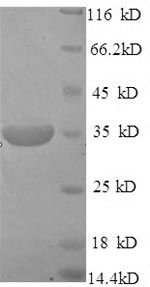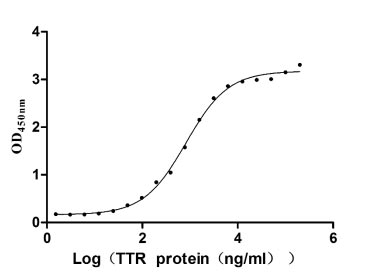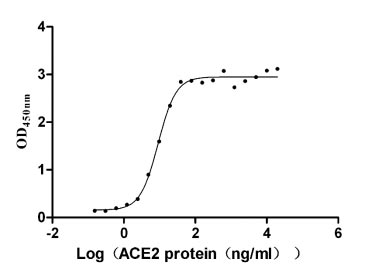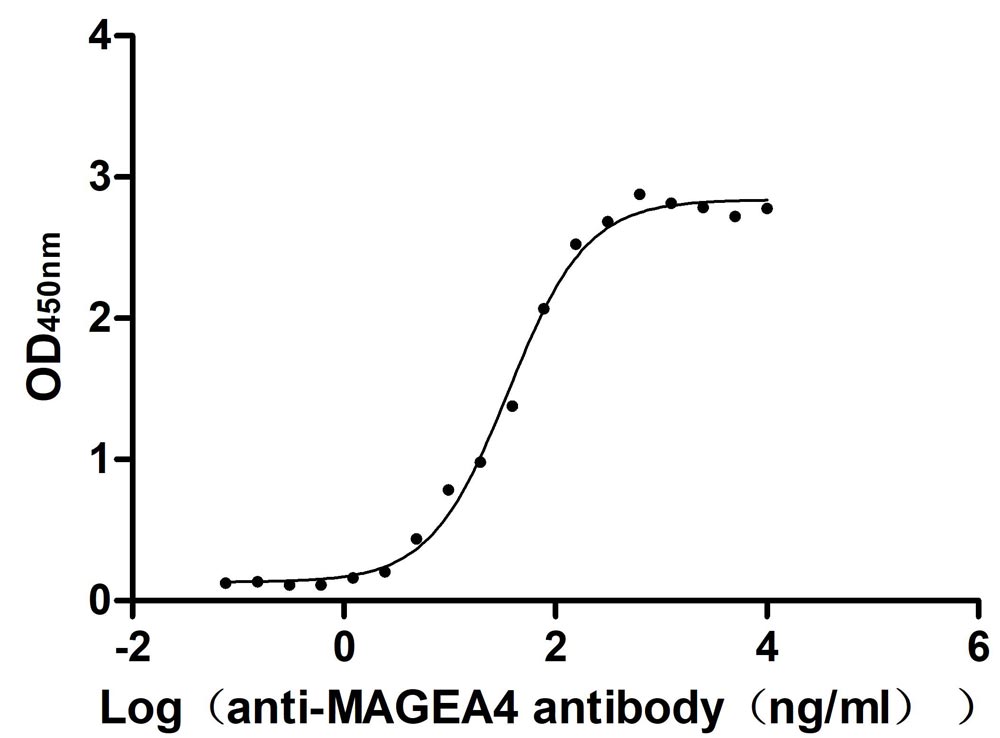Recombinant Mouse Pituitary homeobox 3 (Pdia2)
-
中文名称:小鼠Pitx3重组蛋白
-
货号:CSB-YP018044MO
-
规格:¥1836
-
图片:
-
其他:
产品详情
-
纯度:Greater than 90% as determined by SDS-PAGE.
-
基因名:Pitx3
-
Uniprot No.:
-
别名:Pitx3; Pituitary homeobox 3; Homeobox protein PITX3; Paired-like homeodomain transcription factor 3
-
种属:Mus musculus (Mouse)
-
蛋白长度:Full Length
-
来源:Yeast
-
分子量:33.7kDa
-
表达区域:1-302aa
-
氨基酸序列MEFGLLGEAEARSPALSLSDAGTPHPPLPEHGCKGQEHSDSEKASASLPGGSPEDGSLKKKQRRQRTHFTSQQLQELEATFQRNRYPDMSTREEIAVWTNLTEARVRVWFKNRRAKWRKRERSQQAELCKGGFAAPLGGLVPPYEEVYPGYSYGNWPPKALAPPLAAKTFPFAFNSVNVGPLASQPVFSPPSSIAASMVPSAAAAPGTVPGPGALQGLGGAPPGLAPAAVSSGAVSCPYASAAAAAAAAASSPYVYRDPCNSSLASLRLKAKQHASFSYPAVPGPPPAANLSPCQYAVERPV
Note: The complete sequence including tag sequence, target protein sequence and linker sequence could be provided upon request. -
蛋白标签:N-terminal 6xHis-tagged
-
产品提供形式:Liquid or Lyophilized powder
Note: We will preferentially ship the format that we have in stock, however, if you have any special requirement for the format, please remark your requirement when placing the order, we will prepare according to your demand. -
缓冲液:Tris-based buffer,50% glycerol
-
储存条件:Store at -20°C/-80°C upon receipt, aliquoting is necessary for mutiple use. Avoid repeated freeze-thaw cycles.
-
保质期:The shelf life is related to many factors, storage state, buffer ingredients, storage temperature and the stability of the protein itself.
Generally, the shelf life of liquid form is 6 months at -20°C/-80°C. The shelf life of lyophilized form is 12 months at -20°C/-80°C. -
货期:Basically, we can dispatch the products out in 1-3 working days after receiving your orders. Delivery time may differ from different purchasing way or location, please kindly consult your local distributors for specific delivery time.Note: All of our proteins are default shipped with normal blue ice packs, if you request to ship with dry ice, please communicate with us in advance and extra fees will be charged.
-
注意事项:Repeated freezing and thawing is not recommended. Store working aliquots at 4°C for up to one week.
-
Datasheet & COA:Please contact us to get it.
相关产品
靶点详情
-
功能:Transcriptional regulator which is important for the differentiation and maintenance of meso-diencephalic dopaminergic (mdDA) neurons during development. In addition to its importance during development, it also has roles in the long-term survival and maintenance of the mdDA neurons. Activates NR4A2/NURR1-mediated transcription of genes such as SLC6A3, SLC18A2, TH and DRD2 which are essential for development of mdDA neurons. Acts by decreasing the interaction of NR4A2/NURR1 with the corepressor NCOR2/SMRT which acts through histone deacetylases (HDACs) to keep promoters of NR4A2/NURR1 target genes in a repressed deacetylated state. Essential for the normal lens development and differentiation. Plays a critical role in the maintenance of mitotic activity of lens epithelial cells, fiber cell differentiation and in the control of the temporal and spatial activation of fiber cell-specific crystallins. Positively regulates FOXE3 expression and negatively regulates PROX1 in the anterior lens epithelium, preventing activation of CDKN1B/P27Kip1 and CDKN1C/P57Kip2 and thus maintains lens epithelial cells in cell cycle.
-
基因功能参考文献:
- that Pitx3 is co-recruited to regions that foster the formation of GATA-bHLH-BRN complexes, which usually involve Lmo co-regulatory proteins PMID: 27514757
- in absence of En1 and Pitx3, only a limited number of Mesodiencephalic dopaminergic neurons are present in mouse embryo. PMID: 28800615
- Pitx3 is specifically required for DA-related function and, if impaired, Pitx3 could contribute during the pathogenesis of Parkinson's disease. PMID: 26363812
- the sonic hedgehog signaling pathway is both necessary and sufficient for the induction of ectopic PITX3 expression in chick mesencephalon downstream of WNT9A-induced LMX1a transcription. PMID: 26755703
- microphthalmos/aphakia inPITX3 nonsense mutant is caused by the expression of truncated PITX3, resulting in the abnormal expression of downstream targets and lens fiber proteins. PMID: 25347445
- Pitx3 binds to an evolutionary conserved bicoid-binding site on the 5'-upstream region of Foxe3. Pitx3 binding to 5'-upstream region of Foxe3 increased transcriptional activity significantly in a cell-based reporter assay. PMID: 24307298
- Pitx3 overexpressing mouse significantly affects the gene expression of midbrain dopamine neurons. Motor coordination and locomotion activities are significantly affected in mice overexpressing Pitx3 mice. PMID: 24680684
- Primary fetal neurobehavioral deficit of the Pitx3 mutation is akinesia related to nigrostriatal damage. PMID: 23489835
- Two crucial mediators of mesodiencephalic dopaminergic neuronal development, En1 and Pitx3, interact in dopaminergic subset specification. PMID: 23863478
- a novel link between Pitx3 function and the selective pattern of midbrain dopaminergic neurons cell loss observed in Parkinson's disease. PMID: 23331067
- Reduced Th expression was associated with loss of Pitx3. PMID: 23145024
- Pitx3 mutant mice are a convenient and valid mouse model to study the compensatory 5-HT upregulation PMID: 23159831
- The Pitx3 gene is well known for its specific expression in mdDA neurons and is present at the onset of terminal differentiation. PMID: 22870339
- Pitx3 acts on multiple levels in the molecular subset-specification of mdDA neurons. PMID: 22069189
- Pitx3-deficient aphakia mice display unique behavioral responses to psychostimulant and antipsychotic drugs PMID: 20026251
- The frame-shift mutation (Pitx eyl ) affects the C-terminal part of the transcription factor Pitx3 and causes alterations in the eye and brain. PMID: 20033184
- A homeodomain protein that is required for development of substantia nigra dopaminergic neurons. PMID: 12655058
- only a subset of mesencephalic dopaminergic neurons expresses Pitx3, and in Pitx3-deficient aphakia mice, this subset is progressively lost by apoptosis during fetal and postnatal development PMID: 12702666
- In Pitx3-deficient ak/ak mice, dopamine neurons in the substantia nigra fail to develop properly, and dopamine levels are reduced in the striatum. PMID: 12829322
- Pitx3 is specifically required for the formation of the substantia nigra subfield at the onset of dopaminergic neuron differentiation. PMID: 14973278
- Pitx3 specifies and maintenains A9-like neuronal properties, while Nurr1 influences overall midbrain DA specification. These findings may be important for modifying ES cells to generate an optimal cell source for transplantation therapy of PD. PMID: 15691706
- Pitx3 regulates tyrosine hydroxylase expression in the substantia nigra and identifies a subgroup of mesencephalic dopaminergic progenitor neurons during mouse development. PMID: 15950611
- In conclusion, PITX3-deficient mice display specific molecular and cellular alterations in the mDA system that provide new insights in compensatory mechanisms present in mDA-associated disorders such as PD. PMID: 16140547
- pitx3 deficiency in a natural mouse mutant, the aphakia mouse, was correlated with the loss of these neurons and with a deficit in locomotor activity PMID: 16269007
- Pitx3-deficient mice have neural adaptations at the level of the nucleus accumbens microcircuitry that in turn may have behavioral consequences. PMID: 16837663
- Pitx3 is involved in a mdDA developmental cascade linked to RA signaling. PMID: 17592014
- investigation of role of miRNAs in midbrain dopaminergic neurons (DNs); miR-133b regulates the maturation and function of midbrain DNs within a negative feedback circuit that includes the paired-like homeodomain transcription factor Pitx3 PMID: 17761882
- Myogenic basic helix-loop-helix regulatory factor activation of Pitx3 transcription may be part of a positive feedback loop contributing to establishment of the myogenic program PMID: 17848564
- Phenotypic segregation of aphakia and Pitx3-null mutants reveals that Pitx3 deficiency increases consolidation of specific movement components. PMID: 17919745
- Motor deficits and altered striatal gene expression in aphakia (ak) mice. PMID: 17949697
- Reduction in 5-HT levels in Pitx3-deficient mice decreased their locommotor activity to normal levels and increased the locomotor activity of control mice. PMID: 18215235
- Use of a Pitx3-enhanced green fluorescent protein (Pitx3-eGFP) knock-in mouse blastocyst-derived embryonic stem (mES) cell line and flow cytometry) to select and purify midbrain dopamine neurons. PMID: 18388307
- Pitx3-CreER mice show restricted Cre expression in developing ocular lens and skeletal muscle. PMID: 18543300
- Pitx3-deficient Aphakia mice are impaired in striatum-dependent cognitive tasks including rotarod learning, T-maze and inhibitory avoidance tasks, but not the striatum-independent social transmission of food preference task. PMID: 18573342
- Pitx3 is essential to maintain lens epithelial phenotype and prevent inappropriate fibre cell differentiation during lens development PMID: 19007884
- Data found that reduced expression of Pitx3 leads to changes in the proliferation, differentiation and survival of lens cells. PMID: 19334279
- Our study, using Pitx3-deficient embryonic stem cells in an in-vitro differentiation culture system, allowed us to assess the role of Pitx3 in the specification and final maturation of dopaminergic neurons. PMID: 19508691
显示更多
收起更多
-
相关疾病:Mutations in Pitx3 appear to be the cause of the aphakia (ak) phenotype, a recessive homozygous disease characterized by small eyes and closed eyelids.
-
亚细胞定位:Nucleus.
-
蛋白家族:Paired homeobox family, Bicoid subfamily
-
组织特异性:Highly expressed in developing eye lens. Expression is restricted to the substantia nigra and ventral tegmental area in the midbrain.
-
数据库链接:
KEGG: mmu:18742
STRING: 10090.ENSMUSP00000026259
UniGene: Mm.6255
Most popular with customers
-
Recombinant Human Retinol-binding protein 4 (RBP4) (Active)
Express system: Mammalian cell
Species: Homo sapiens (Human)
-
Recombinant Human SARS coronavirus Spike glycoprotein (S), partial (Active)
Express system: Mammalian cell
Species: Human SARS coronavirus (SARS-CoV) (Severe acute respiratory syndrome coronavirus)
-
Recombinant Human Pro-neuregulin-1, membrane-bound isoform (NRG1), partial (Active)
Express system: Mammalian cell
Species: Homo sapiens (Human)
-
Recombinant Human Tumor necrosis factor ligand superfamily member 8 (TNFSF8), partial (Active)
Express system: Mammalian cell
Species: Homo sapiens (Human)
-
Recombinant Human Melanoma-associated antigen 4 (MAGEA4) (Active)
Express system: Mammalian cell
Species: Homo sapiens (Human)
-
Recombinant Mouse Claudin-18 (Cldn18)-VLPs (Active)
Express system: Mammalian cell
Species: Mus musculus (Mouse)
-
Recombinant Human Glucagon-like peptide 1 receptor (GLP1R), partial (Active)
Express system: Mammalian cell
Species: Homo sapiens (Human)
-
Recombinant Human Tumor-associated calcium signal transducer 2 (TACSTD2), partial (Active)
Express system: Mammalian cell
Species: Homo sapiens (Human)





-AC1.jpg)


-AC1.jpg)












